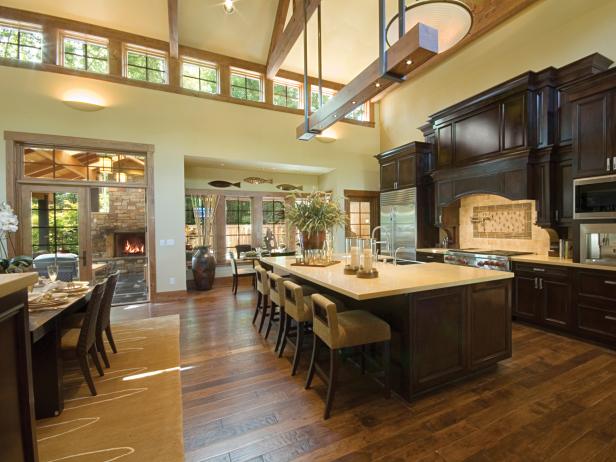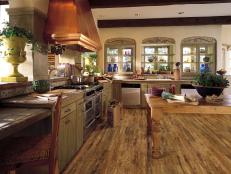Hardwood Flooring in the Kitchen

Considered by many to be the ultimate floor choice, hardwood never goes out of style. This classic floor lends natural beauty and warmth to your kitchen; every board brings rich details achieved with nature and craftsmanship. It's not the most comfortable floor to stand on for long periods of time, so dedicated cooks might want to put down mats or area rugs. But hardwood stands up to spills and stains.
Hardwood is often installed throughout the house for a seamless look. Though hardwood lasts for years, you can get fresh looks down the road by refinishing, staining, and even painting the kitchen floors.
Hardwood Kitchen Floors
See All PhotosWhat You Need to Know
The Lowdown: Hardwood flooring refers to floor boards manufactured from timber.
Tough Enough? When treated right, hardwood floors last a lifetime. But beware of pets' claws and high heels, never leave standing water, and consider window treatments to limit sunlight.
How to Clean: Wipe up spills immediately. Sweep, dust, or vacuum regularly and occasionally wipe the surface with a damp mop or cloth. Avoid oil-based sprays, waxes, and polishes, as well as abrasive cleansers.
Underlayment. Underlayment products provide a base for the floor, limits noise, and adds insulation. Cushioned materials such as cork and form are ideal beneath floating wood floors. In moisture-prone areas, vinyl- and plastic-lined underlayments are best. Many manufacturers offer multiple options featuring unique benefits and price points.
Types of Hardwood Floors
Choose from two types of hardwood: solid or engineered. Both are suitable for the kitchen and offer benefits.
Solid Hardwood is milled from a single piece of wood. The typical choice for wood "purists," this type of floor can be sanded and refinished repeatedly. Because it's susceptible to humidity, it can't be installed in damp spaces—so keep that in mind if your kitchen is particularly prone to water spills.
Solid hardwood comes prefinished (for easier installation) or unfinished (for on-site finishing, which can offer more stain options). It is usually nailed or stapled to a wooden subfloor, though very thin types are sometimes glued.
Engineered Hardwood is created by bonding layers of hardwood ("plies") together in a cross-grain construction. This type of hardwood is more stable and withstands more humidity, and can be installed over concrete subfloors.
Engineered hardwood almost always comes pre-finished. A greener option, it utilizes less milled lumber. It offers greater flexibility in installation, as it can be stapled, glued, or floated (attached to itself rather than the subfloor).
Considerations When Choosing Hardwood Floors
You'll find hardwood flooring that suits virtually any style. Here are some considerations to keep in mind when choosing your wood:
Species. Hardness, stability, graining, and color are all in part determined by wood species. For domestic species, oak is generally the most common; other options include cherry, maple, walnut, hickory, and birch. Many homeowners love the look of exotics, such as jatoba, teak, Tigerwood, and Brazilian cherry.
Width. Wide planks (more than three inches) lend rustic style to country kitchens. Strips (less than three inches) offer sleeker style for contemporary spaces. Decorative parquet floors are a distinctive addition to more formal kitchens.
Texture. Aged hardwood lends history and heritage with notches, adze marks, and wormholes. You can find brand-new wood with the same timeworn appearance, thanks to special distressing techniques, including hand-scraping, wire-brushing, and chattering.
Color. Hardwood colors range from blond to caramel, burgundy to brown, and even black. In the kitchen, keep in mind that extremely light or dark floors tend to show spills more readily.







































